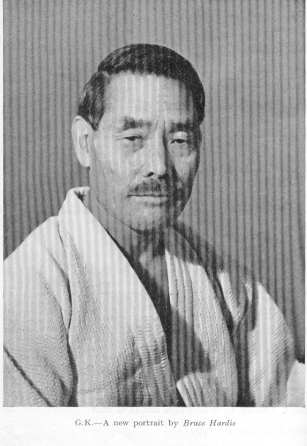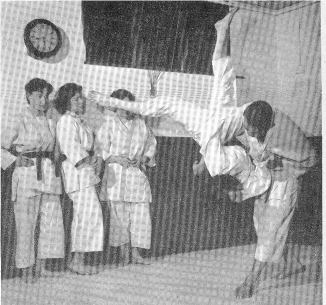Judo
By Gunji KoizumiFrom Budokwai Quarterly Bulletin, April 1945 to January 1946, 5-6. Reprinted courtesy of Richard Bowen on behalf of the Budokwai. Copyright © 2000 the Budokwai, London, England.
"Why don't you write a book on judo?" This has been said to me more than once.
Sometimes, I recollect with a sense akin to envy those young days when the mind was simple enough to be satisfied with dictionary definitions and when I thought I had mastered chemistry as soon as I had learned the chemical compound of water.
At the age of 25 I could write with confidence, but after 40 years' experience I have that confidence no longer, and I am more convinced and appreciative of the saying of Laotze, the Chinese philosopher of ancient days -- "When you say it is, it is not."
Reality is so vast yet so rarified it eludes all human words, so vague, and the mind so finite. No wonder those great teachers of the past left no writing and mostly taught in parables. What one acquires cannot be described; it can only be realised through personal experience.

I have made attempts and laboured to describe the complex movements and actions involved in judo. But it seems the more I try, the more I am entangled in the forest of paragraphs and semi-paragraphs, phrases and paraphrases. At the end it looks a perfect pickle! Yes, a perfect pickle, indiscernible in its ingredients or the part to be played by each part of every part of the body. Even with a simple action, such as a push or pull, one must to attain maximum efficiency obtain the rhythmical co-ordination of every muscle, and the toes, heels, ankles, knees, hips, spine, shoulders, elbows, wrists, fingers, all must work together in unison. Then the posture, distribution of the body weight, the direction and line of movement, etc., must be fitted into each other. Then the whole amounts to but a mere suggestion -- understandable only by those who have had common experience.
Judo, mere knowledge of it, is inclined to give one indigestion, and makes one "repeat" as a book-stuffed philosopher. When it is digested and assimilated by diligent practice, it becomes a power that makes things grow, that gives self-reliance and self-confidence.
Judo, like any other art, cannot be taught, but a master can help to develop one's innate potentiality. Therefore, one cannot deal out judo as a commercial commodity over the counter.
Judo is a principle, an active principle and it manifests itself in many phases. That is the reason why, while it appears to some as cute tricks of self-defence, some can enjoy practising it as a sport and as a means for physical exercise, and some get inspiration from it for mental, philosophical and spiritual attainments. In fact, judo has not yet been subjected to a searching scientific study, for it has been developed on the plane of natural and dynamic laws, "maximum efficiency and minimum expenditure" as a guiding principle without those dogmatic restrictions which hamper natural progress. One day it will be recognised as the best form of mental and physical education and health-giving exercise.
No doubt there were some forms of fighting
ever since life appeared on the Earth, but it is quite obvious that the
art of judo started to develop into the present form in the days when the
samurais held to their high sense of honour the principle of fighting on
equal terms, so that in the battlefield if one's opponent loses his sword
one would throw away one's own, and continue the combat unarmed. Such samurais
had to prepare themselves to meet all comers by inventing new methods of
attaining skill in unarmed combat. This was in the 10th century when the
feudal system originated in Japan, but schools teaching this form of fighting
were not established until the 18th century. Whatever the origin and the
original aims of judo might have been, we derive to-day more benefit from
the training for skill than from skill attained.

Attaining the grade of black belt really
means one has become "teachable". Before that it is like preparing for
matriculation. To be qualified as a teacher one must reach at least 6th
Dan.
The art of judo, in short, can be said to be based on the laws of physics which govern "balance and leverage". Firstly, the aim is to unbalance the opponent; secondly, by using one's body as a lever, to overcome him with a throw or lock. This is called Tsukuri and Kake or "preparation and application." I will deal with this matter more in detail in the next Bulletin.
Photo of Gunji Koizumi appeared in the July 1951 "Budokwai Quarterly Bulletin." The photo was taken by Bruce Hardie, and is reprinted courtesy Richard Bowen, on behalf of the Budokwai. Copyright (c) 2000 by the Budokwai, London, England, all rights reserved.
Second photo credit:
Gunji Koizumi demonstrating with Iris Dehnel, now 2nd Dan, watched by Ann
Snow, 2nd Kyu, now in Madrid, Yvonne Myers, now 2nd Dan, and Doreen Tilley,
now 1st Kyu. From _Budokwai Quarterly Bulletin_, January 1955. Copyright
(c) 2000 the Budokwai, all rights reserved. Used by permission.